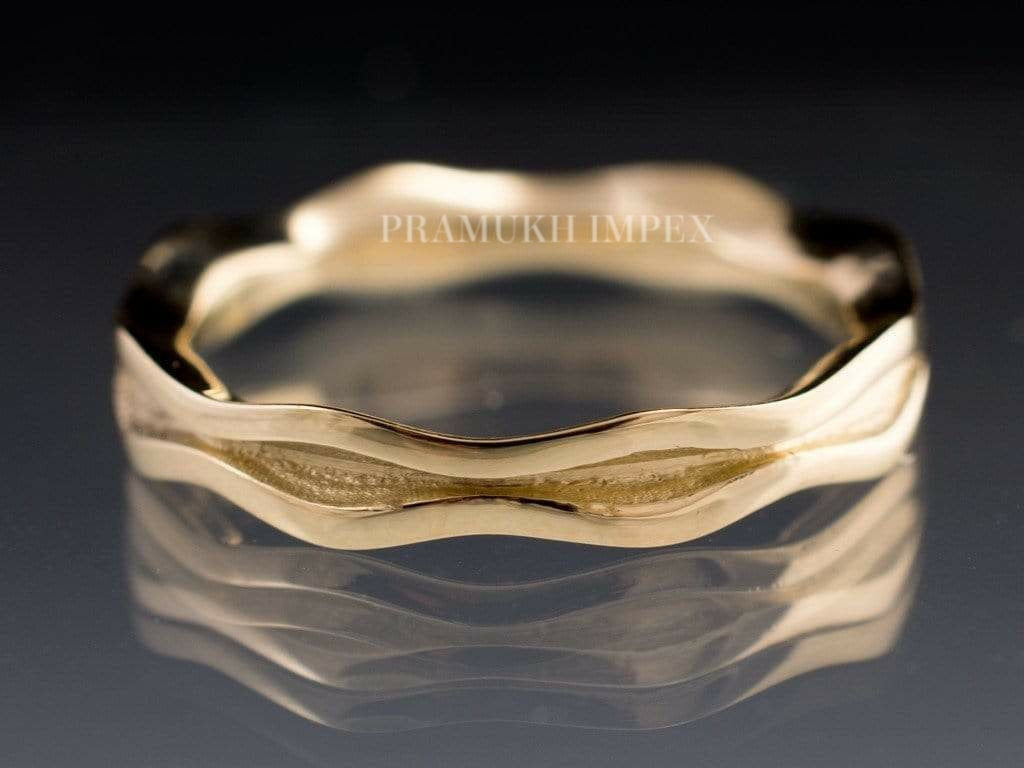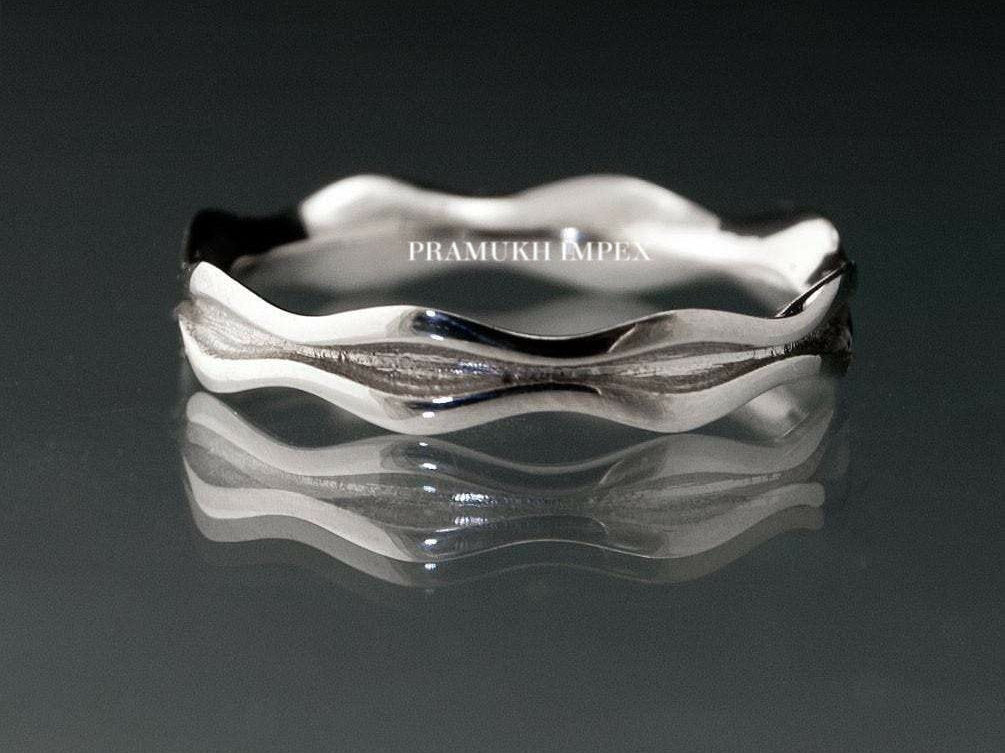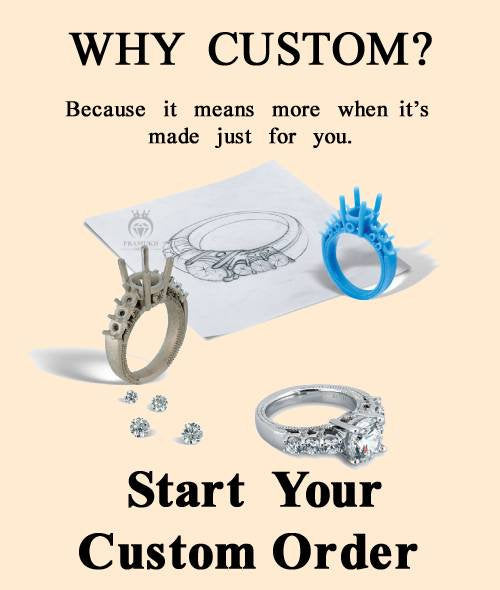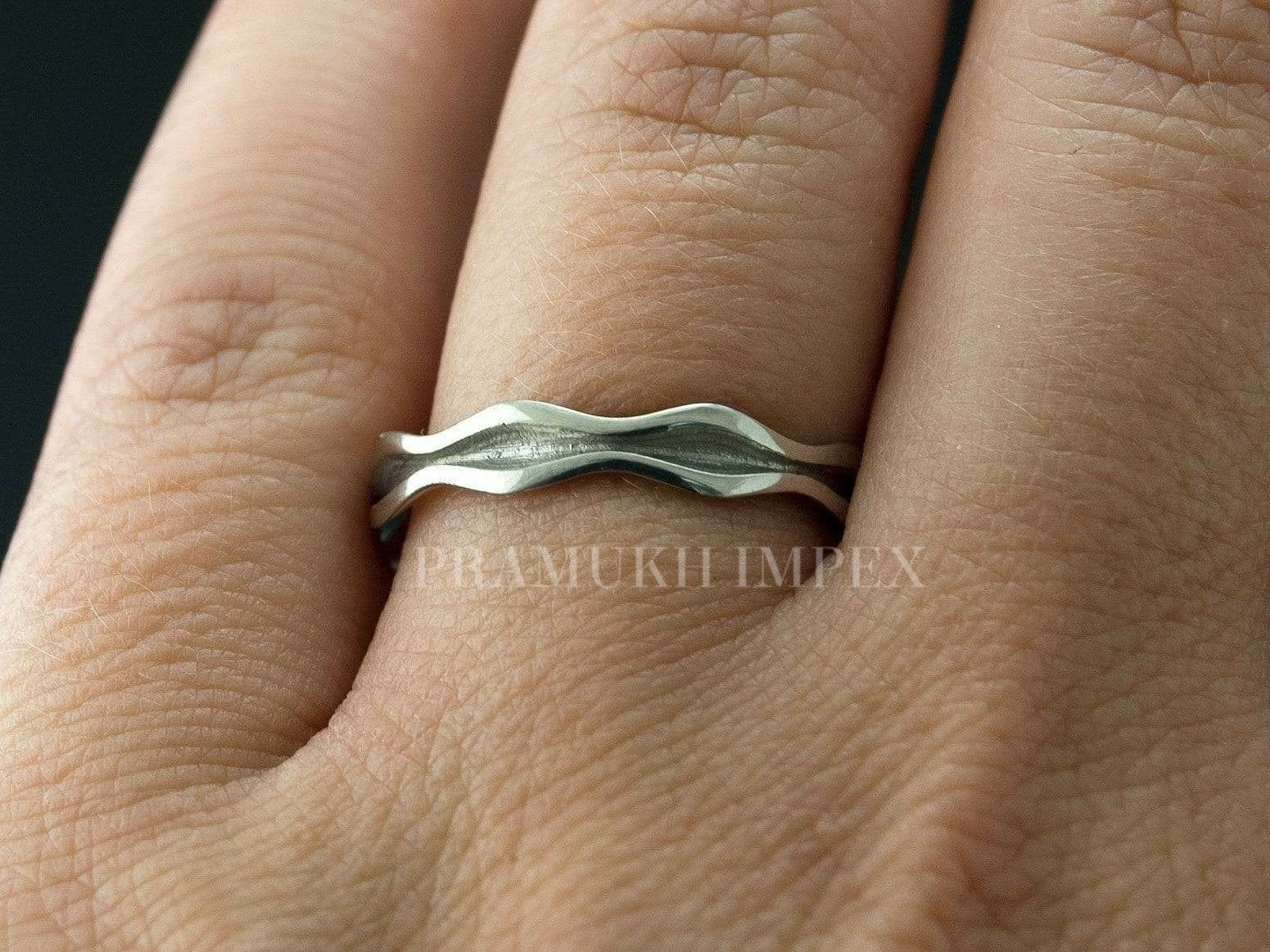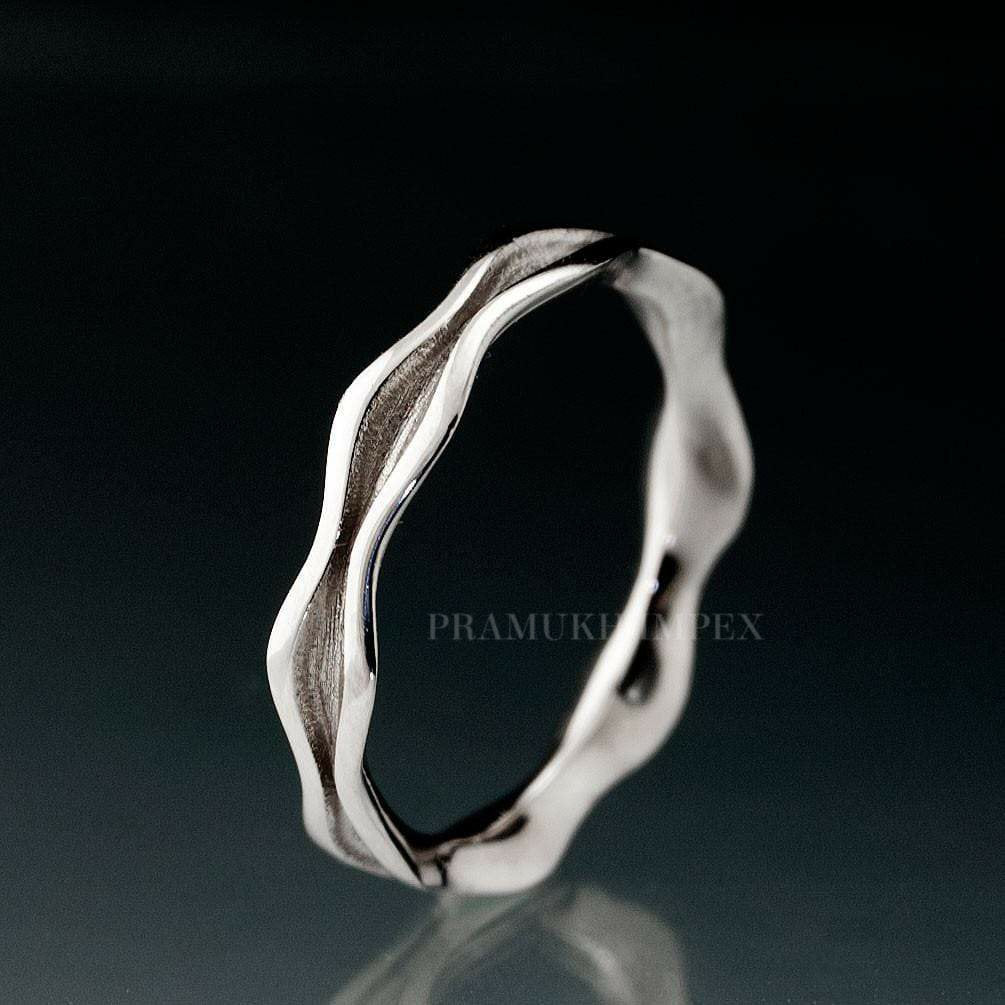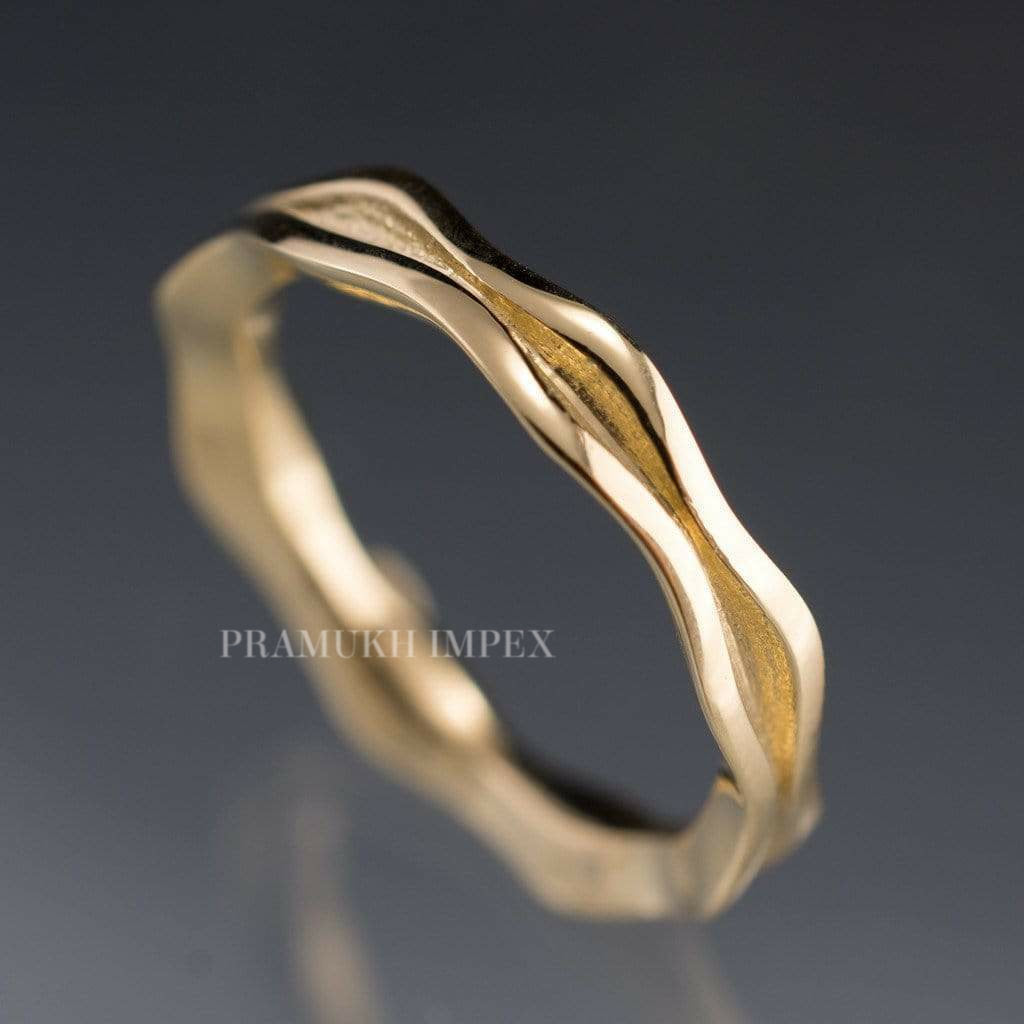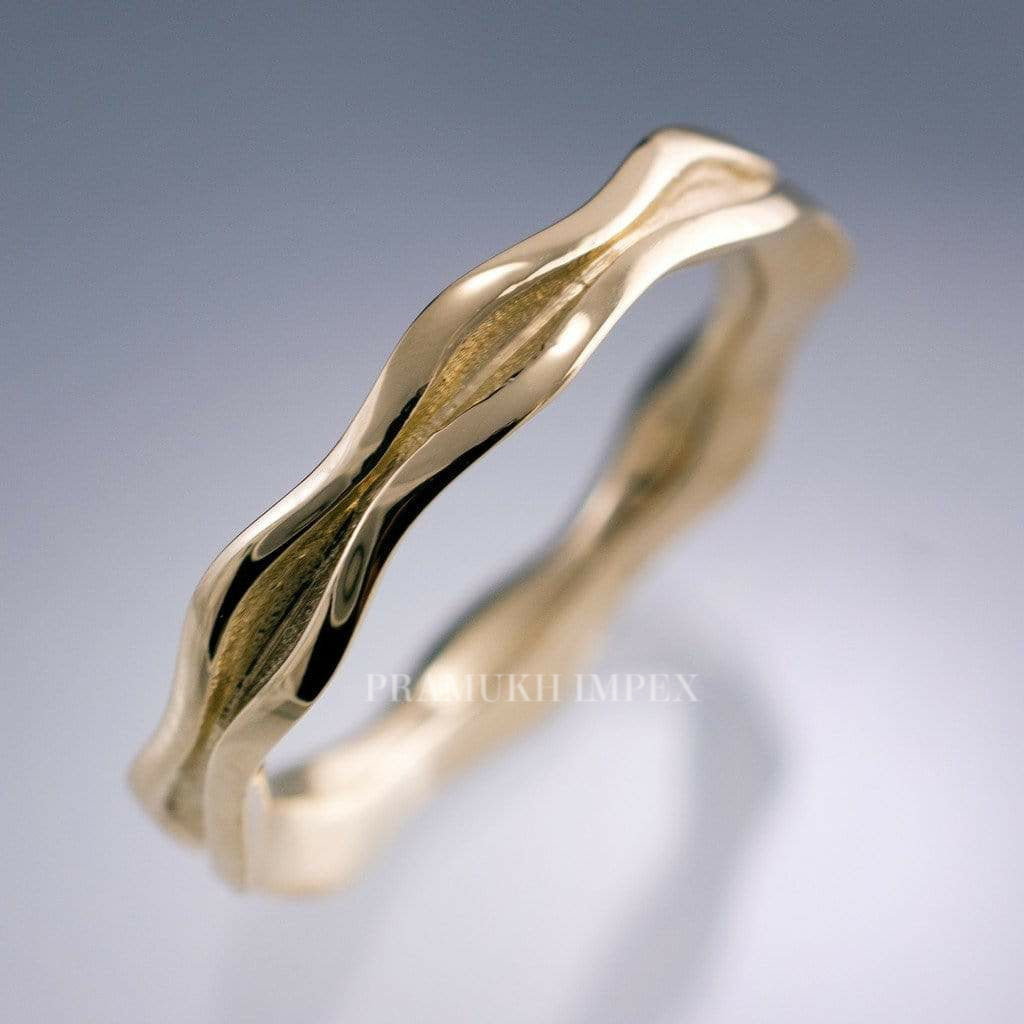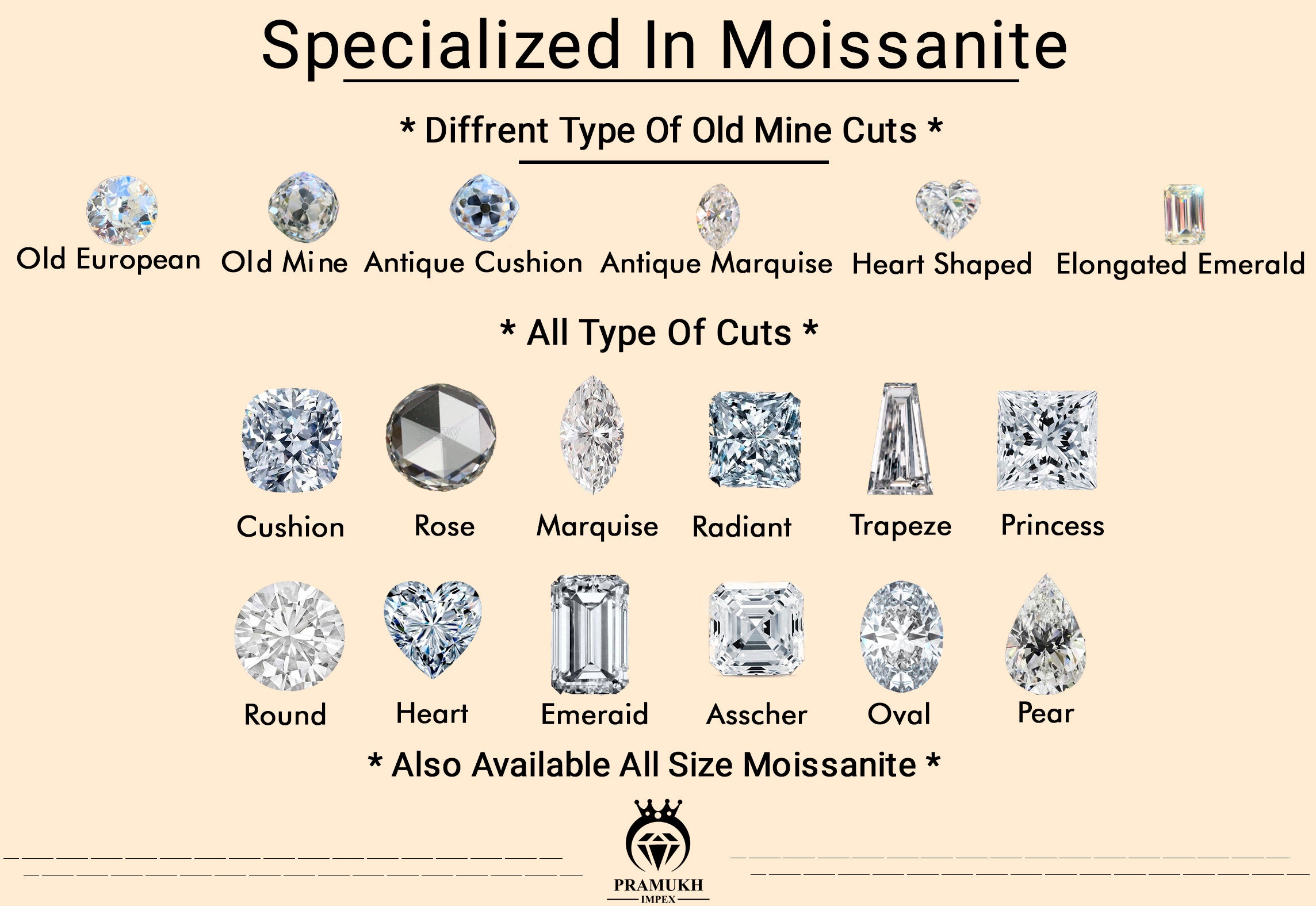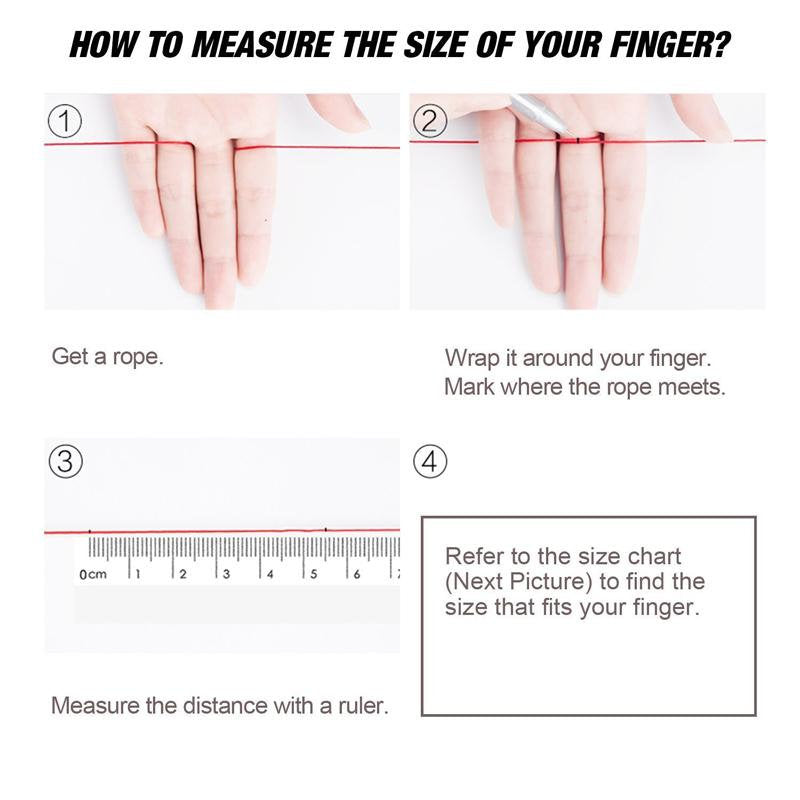Product Specification
Antique Wedding Band, 14k Wave Narrow Engagement Ring , Stackable Ring , Moissanite Wedding Ring , Art Deco Wedding Band , Antique Gold Band. Narrow wedding band that features a wavy design with a pod-like appearance. This unconventional stacking wedding ring is simple yet stylish with very organic fluid movements. This ring is cast and finished in my studio in Surat City.
The stones in jewelry are 100% hand-crafted it is cut and polished by our experienced craftsman.
Moissanite is diamonds best alternative.
Description of Ring
___________________________
● Metal Details
→ Metal Type: Gold
→ Metal Purity: 14 KT
→ Metal Tone: White/Yellow
→ Metal Stamp: Yes
● Band:
Ring, as shown, is 2.0mm at the narrow areas and 3.50mm at the widest part. The metal is highly polished with a matte lightly grainy texture inside the pods. Multiple rings can be worn stacked.
● Vintage
=================
When a ring has been previously owned but it was made anytime in the last 100 years from the present date, we call it "vintage". The rules get a little fuzzy in this category, but “vintage” typically refers to engagement rings that are at least 20-30 years old, but less than 100 years old, and have been previously owned. The majority of engagement rings in our collection are authentically vintage, coming from the Art Deco, Retro, and Modern eras (1915 - the late 1960’s).
● Vintage-Inspired
=====================
Finally, any ring that is newly made, has not been previously owned, and was made to look like a vintage or antique ring is considered "vintage-inspired". Most rings from national retailers that are labeled "vintage" are actually "vintage-inspired", because they are brand new and have never been owned by anyone before. Vintage-inspired rings often use antique or vintage cut diamonds such as the Old Mine Cut or Old European Cut but have newly made settings. Knowing what "vintage" actually means will help you purchase a ring - maybe a vintage-inspired engagement ring is what you're after, or maybe you're looking for an engagement ring already rich with history that was made in another era. The choice is yours!
***************************
Jewelry Time Periods
***************************
Georgian (1714 - 1830)
======================
Jewelry from the Georgian Period is quite rare. Most Georgian antique jewelry we do find today has been taken apart or modified to reflect the trends that were happening during the time. Most surviving jewelry from this period is handmade, typically with 18K gold and silver. Because gold was so expensive during the Georgian period, most diamonds were set in silver that was backed with gold in order to protect the silver from tarnishing over time. One distinguishing factor of the Georgian Period is the shape of the stones used. Jewelry was made to suit the stones that were available, and stones were never cut specifically for a piece of jewelry. It’s typical for a piece of Georgian jewelry to have many different sizes and shapes of stones within a single piece. The cutting techniques we have today were not available in those times, and it was common for jewelers to back the stones in foil to bring out the sparkle that we’re so used to seeing today. Rose cut and Table cut diamonds were very commonly used, as well as sapphires, garnets, precious topaz, and amethysts. Many Georgian rings also include floral, bow, or scrolling motifs.
Victorian (1835 - 1900)
========================
The Victorian Period was named for Queen Victoria, who inherited the throne of England in 1837 when she was only 18 years old. Victoria was young, beautiful, and loved immensely by her subjects. Her tastes in fashion and jewelry were highly regarded and inspired the Victorian jewelry trends of the time. Queen Victoria was married in 1840, and she wore a snake motif ring (a symbol of eternal love at the time) set with her birthstone, a brilliant green emerald, as her engagement ring. In the Victorian era, it was very common for birthstones to be used instead of diamonds for engagement rings. After Victoria’s beloved Albert passed away in 1861, the queen went into the customary mourning period for 18 months, which inspired the gold lockets and black jet pieces commonly seen in this period. Nearing the end of the Victorian period, the discovery of diamonds in South Africa helped popularize diamonds again. Additionally, this historical period is where the very first diamond solitaire engagement rings originated! At the turn of the century, society was at the height of the industrial revolution and the jewelry of the time period reflected the dawning of a new modern age. Queen Victoria passed away in 1901 after a 64-year reign, marking the end of an era and the beginning of a new one when her son Edward ascended the throne, ushering in the Edwardian era.
Edwardian (1900 - 1915)
=========================
Queen Victoria’s son, Edward VII, took the throne in 1901. Society was at the height of its elegance and sophistication: it was during this time that advances in metal fabrication finally allowed for the use of platinum in jewelry (which still remains extremely popular today). This advance makes jewelry dating much easier - if a piece is made with platinum, we can be fairly sure that it was made in the early 20th century or later. In addition, it was still common practice for jewelers to back platinum pieces with gold until 1910 or so, making dating even more precise. Because of the strength of platinum, its use allowed jewelers to produce more intricate, detailed pieces. Some Edwardian engagement rings are so detailed it appears that the diamonds are set in lace instead of metal. Jewelry from the Edwardian period was light and delicate, and using as many diamonds as possible in a design was essential. The overall style of the times was light, feminine, and airy. Women commonly wore white, white, and more white. Diamonds were the gemstone of choice during the time, but we also see sapphires, aquamarines, and most notably, electric green demantoid garnets from Russia, which are very rare to find in larger sizes. Additionally, a new type of decorative enhancement called “milgraining” was used extensively during this period. Milgraining involves a small border of platinum beads set around the edges of a piece of jewelry that adds a soft, elegant look. The end of the Edwardian era came abruptly with the start of World War I in 1914. Gone was the lightheartedness of the times: people began to hide or sell all their jewelry, and platinum became scarce due to the demand for its use in the war effort.
Art Deco (1915 - 1935)
======================
When World War I began in 1914, manufacturing of jewelry came to a stop. The hard times brought on by the war also marked the end of the fashions and trends that were popular in the Edwardian era. Women were needed to take over men’s roles in the workplace while they were at war, and they started learning valuable skills and earning their own money. This change combined with winning the right to vote in 1920 lead to independence and emancipation for women. When the war ended, the “Roaring 20’s” ushered in a new attitude and an overall desire to live life to the fullest - an attitude that was very much reflected in the new jewelry design trends. The most characteristic feature of Art Deco jewelry is the emphasis on bold, geometric designs. Lines were straight and linear, and gemstone shapes most often followed suit. Calibre cut sapphires, rubies, and emeralds were used to add splashes of color to otherwise diamond-centric jewelry. Black onyx and red coral were also used often as accent colors. When King Tutankhamen's tomb opened in 1922 there was a return to Egyptian revival jewelry as well. Platinum was still the metal of choice, but white gold was also popular since the cost of platinum was so high. Women wore multiple bracelets stacked on their wrists, as well as long strands of cultured pearls, which complemented flapper-style fringed skirts and backless dresses. Major designers of the time were Tiffany, Cartier, Van Cleef, and Arpels, Harry Winston, Lalique, and Mauboussin, among others. Their great influence of jewelry design and impeccable reputations were well earned and still stand true today.
Retro (1935-1950)
==================
Jewelry design regained speed in the late 1930’s after the United States began its recovery from the collapse of the stock market in 1929 and the subsequent Great Depression. Hollywood and all its glamour became the influence of Retro jewelry: it is easily identifiable by the use of bright, highly polished yellow, rose, and green gold. The jewelry is big, bold, and three dimensional. Large emerald cut semi-precious gemstones were the star of this era, namely amethyst, aquamarine, and citrine. These large stones were often accented by small diamonds and calibre cut rubies and sapphires. Due to the beginning of World War II in 1941, platinum became scarce again and gold was the metal of choice. Common design themes from this era include big flowing ribbons and bows, as well as the use of flowers and even animals. Wide gold bracelets, oversized dress clips and earrings that were worn high up on the ear were all popular styles. Notable designers of this time were Verdura, Oscar Heyman, Buccellati, and William Russer, among many others.
Warranty and Service:
___________________________
● Genuine Natural Diamond 100%
● We offer 45 day's warranty on all our Loose diamonds or Jewelry.
● We also provide paid service after completion of warranty.
● You can send us an email or can send a message on Etsy 24x7 for any service required thereafter.
Thank you for visiting our store, see you soon
Customized or Personalized Orders Process ?
We will be pleased to receive the customized and personalized order.
We have a simple procedure for customized order, the steps are as below
A) Start a conversation with us and send us the message asking for customized jewellery. You will get a reply within a few hours, as soon as one of our team member have your message.
B) Please send us the design you would like us to make it for you, or discuss the idea with us we can also design it for you.
C) We make jewelry using, Moissanite or Sapphire or any other gemstones as required by you. We can make jewelry in 925 Silver, 10K, 14K, 18K and in Platinum. We can make it in White, Yellow, and Rose Gold,platinum.
D) We will send you CAD before we make the ring and send you images of a completed ring.



Antique Wedding Band, 14k Wave Narrow Engagement Ring , Stackable Ring , Moissanite Wedding Ring , Art Deco Wedding Band , Antique Gold Band. Narrow wedding band that features a wavy design with a pod-like appearance. This unconventional stacking wedding ring is simple yet stylish with very organic fluid movements. This ring is cast and finished in my studio in Surat City.
The stones in jewelry are 100% hand-crafted it is cut and polished by our experienced craftsman.
Moissanite is diamonds best alternative.
Description of Ring
___________________________
● Metal Details
→ Metal Type: Gold
→ Metal Purity: 14 KT
→ Metal Tone: White/Yellow
→ Metal Stamp: Yes
● Band:
Ring, as shown, is 2.0mm at the narrow areas and 3.50mm at the widest part. The metal is highly polished with a matte lightly grainy texture inside the pods. Multiple rings can be worn stacked.
● Vintage
=================
When a ring has been previously owned but it was made anytime in the last 100 years from the present date, we call it "vintage". The rules get a little fuzzy in this category, but “vintage” typically refers to engagement rings that are at least 20-30 years old, but less than 100 years old, and have been previously owned. The majority of engagement rings in our collection are authentically vintage, coming from the Art Deco, Retro, and Modern eras (1915 - the late 1960’s).
● Vintage-Inspired
=====================
Finally, any ring that is newly made, has not been previously owned, and was made to look like a vintage or antique ring is considered "vintage-inspired". Most rings from national retailers that are labeled "vintage" are actually "vintage-inspired", because they are brand new and have never been owned by anyone before. Vintage-inspired rings often use antique or vintage cut diamonds such as the Old Mine Cut or Old European Cut but have newly made settings. Knowing what "vintage" actually means will help you purchase a ring - maybe a vintage-inspired engagement ring is what you're after, or maybe you're looking for an engagement ring already rich with history that was made in another era. The choice is yours!
***************************
Jewelry Time Periods
***************************
Georgian (1714 - 1830)
======================
Jewelry from the Georgian Period is quite rare. Most Georgian antique jewelry we do find today has been taken apart or modified to reflect the trends that were happening during the time. Most surviving jewelry from this period is handmade, typically with 18K gold and silver. Because gold was so expensive during the Georgian period, most diamonds were set in silver that was backed with gold in order to protect the silver from tarnishing over time. One distinguishing factor of the Georgian Period is the shape of the stones used. Jewelry was made to suit the stones that were available, and stones were never cut specifically for a piece of jewelry. It’s typical for a piece of Georgian jewelry to have many different sizes and shapes of stones within a single piece. The cutting techniques we have today were not available in those times, and it was common for jewelers to back the stones in foil to bring out the sparkle that we’re so used to seeing today. Rose cut and Table cut diamonds were very commonly used, as well as sapphires, garnets, precious topaz, and amethysts. Many Georgian rings also include floral, bow, or scrolling motifs.
Victorian (1835 - 1900)
========================
The Victorian Period was named for Queen Victoria, who inherited the throne of England in 1837 when she was only 18 years old. Victoria was young, beautiful, and loved immensely by her subjects. Her tastes in fashion and jewelry were highly regarded and inspired the Victorian jewelry trends of the time. Queen Victoria was married in 1840, and she wore a snake motif ring (a symbol of eternal love at the time) set with her birthstone, a brilliant green emerald, as her engagement ring. In the Victorian era, it was very common for birthstones to be used instead of diamonds for engagement rings. After Victoria’s beloved Albert passed away in 1861, the queen went into the customary mourning period for 18 months, which inspired the gold lockets and black jet pieces commonly seen in this period. Nearing the end of the Victorian period, the discovery of diamonds in South Africa helped popularize diamonds again. Additionally, this historical period is where the very first diamond solitaire engagement rings originated! At the turn of the century, society was at the height of the industrial revolution and the jewelry of the time period reflected the dawning of a new modern age. Queen Victoria passed away in 1901 after a 64-year reign, marking the end of an era and the beginning of a new one when her son Edward ascended the throne, ushering in the Edwardian era.
Edwardian (1900 - 1915)
=========================
Queen Victoria’s son, Edward VII, took the throne in 1901. Society was at the height of its elegance and sophistication: it was during this time that advances in metal fabrication finally allowed for the use of platinum in jewelry (which still remains extremely popular today). This advance makes jewelry dating much easier - if a piece is made with platinum, we can be fairly sure that it was made in the early 20th century or later. In addition, it was still common practice for jewelers to back platinum pieces with gold until 1910 or so, making dating even more precise. Because of the strength of platinum, its use allowed jewelers to produce more intricate, detailed pieces. Some Edwardian engagement rings are so detailed it appears that the diamonds are set in lace instead of metal. Jewelry from the Edwardian period was light and delicate, and using as many diamonds as possible in a design was essential. The overall style of the times was light, feminine, and airy. Women commonly wore white, white, and more white. Diamonds were the gemstone of choice during the time, but we also see sapphires, aquamarines, and most notably, electric green demantoid garnets from Russia, which are very rare to find in larger sizes. Additionally, a new type of decorative enhancement called “milgraining” was used extensively during this period. Milgraining involves a small border of platinum beads set around the edges of a piece of jewelry that adds a soft, elegant look. The end of the Edwardian era came abruptly with the start of World War I in 1914. Gone was the lightheartedness of the times: people began to hide or sell all their jewelry, and platinum became scarce due to the demand for its use in the war effort.
Art Deco (1915 - 1935)
======================
When World War I began in 1914, manufacturing of jewelry came to a stop. The hard times brought on by the war also marked the end of the fashions and trends that were popular in the Edwardian era. Women were needed to take over men’s roles in the workplace while they were at war, and they started learning valuable skills and earning their own money. This change combined with winning the right to vote in 1920 lead to independence and emancipation for women. When the war ended, the “Roaring 20’s” ushered in a new attitude and an overall desire to live life to the fullest - an attitude that was very much reflected in the new jewelry design trends. The most characteristic feature of Art Deco jewelry is the emphasis on bold, geometric designs. Lines were straight and linear, and gemstone shapes most often followed suit. Calibre cut sapphires, rubies, and emeralds were used to add splashes of color to otherwise diamond-centric jewelry. Black onyx and red coral were also used often as accent colors. When King Tutankhamen's tomb opened in 1922 there was a return to Egyptian revival jewelry as well. Platinum was still the metal of choice, but white gold was also popular since the cost of platinum was so high. Women wore multiple bracelets stacked on their wrists, as well as long strands of cultured pearls, which complemented flapper-style fringed skirts and backless dresses. Major designers of the time were Tiffany, Cartier, Van Cleef, and Arpels, Harry Winston, Lalique, and Mauboussin, among others. Their great influence of jewelry design and impeccable reputations were well earned and still stand true today.
Retro (1935-1950)
==================
Jewelry design regained speed in the late 1930’s after the United States began its recovery from the collapse of the stock market in 1929 and the subsequent Great Depression. Hollywood and all its glamour became the influence of Retro jewelry: it is easily identifiable by the use of bright, highly polished yellow, rose, and green gold. The jewelry is big, bold, and three dimensional. Large emerald cut semi-precious gemstones were the star of this era, namely amethyst, aquamarine, and citrine. These large stones were often accented by small diamonds and calibre cut rubies and sapphires. Due to the beginning of World War II in 1941, platinum became scarce again and gold was the metal of choice. Common design themes from this era include big flowing ribbons and bows, as well as the use of flowers and even animals. Wide gold bracelets, oversized dress clips and earrings that were worn high up on the ear were all popular styles. Notable designers of this time were Verdura, Oscar Heyman, Buccellati, and William Russer, among many others.
Warranty and Service:
___________________________
● Genuine Natural Diamond 100%
● We offer 45 day's warranty on all our Loose diamonds or Jewelry.
● We also provide paid service after completion of warranty.
● You can send us an email or can send a message on Etsy 24x7 for any service required thereafter.
Thank you for visiting our store, see you soon
Customized or Personalized Orders Process ?
We will be pleased to receive the customized and personalized order.
We have a simple procedure for customized order, the steps are as below
A) Start a conversation with us and send us the message asking for customized jewellery. You will get a reply within a few hours, as soon as one of our team member have your message.
B) Please send us the design you would like us to make it for you, or discuss the idea with us we can also design it for you.
C) We make jewelry using, Moissanite or Sapphire or any other gemstones as required by you. We can make jewelry in 925 Silver, 10K, 14K, 18K and in Platinum. We can make it in White, Yellow, and Rose Gold,platinum.
D) We will send you CAD before we make the ring and send you images of a completed ring.




